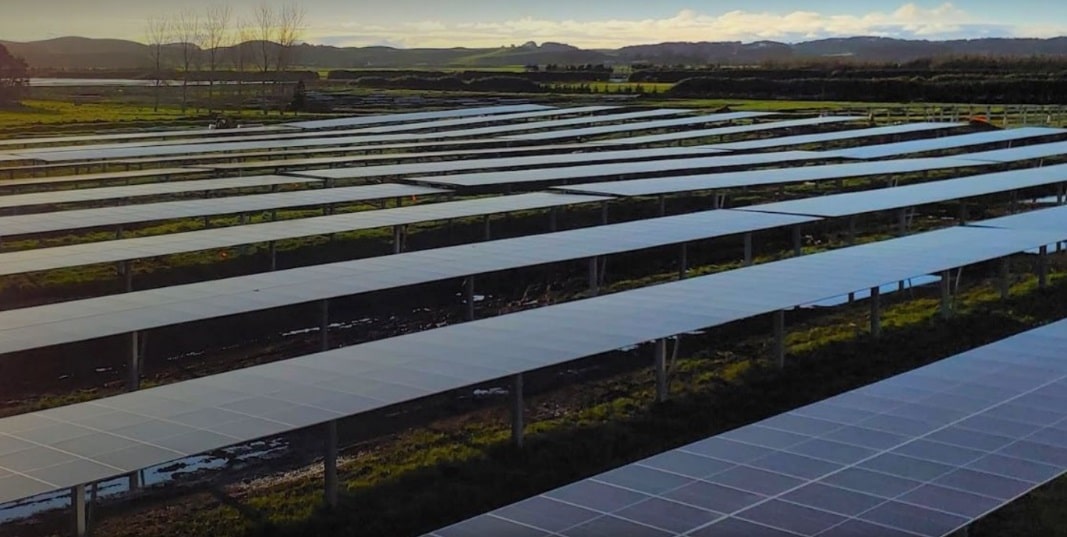
by Jonathan Gardiner | Jul 22, 2024 | Energy, New Zealand Energy Certificates, News, NZ-ECs, solar power, Sustainable Business
Total Utilities is proud to announce its latest venture in the renewable energy market: expanding the sale of unbundled Renewable Energy Certificates (RECs) through a partnership with Lodestone Energy.
This collaboration underscores Total Utilities’ commitment to sustainability and its
dedication to providing innovative energy solutions to a broader customer base, both now
and into the future.
RECs authenticate the production and consumption of renewable energy. They enable
businesses and individuals to offset the carbon associated with electricity consumption and support the development of new renewable energy projects, without directly utilising the energy at the source.
Positioning for Growth in REC Market
Already established as a prominent player in the renewable energy sector, Total Utilities is
now strategically positioned to meet the increasing demand for RECs and sustainable energy solutions through its partnership with Lodestone Energy.
Jonathan Gardiner, Managing Director of Total Utilities explains, “We’re excited to partner
with Lodestone to expand and enhance our renewable energy offerings. This partnership
builds upon our existing relationships with partners such as Pioneer Energy, to meet the
evolving needs of our clients.
“By integrating Lodestone into our network of REC partners, we are better equipped to
address the growing demand for sustainable solutions.”
Funding Solar development
Jonathan emphasises how purchasing RECs supplied by Lodestone through Total Utilities will contribute directly to the development of solar energy in New Zealand: “Lodestone Energy recently launched the first grid-scale solar farm in Kaitaia. By purchasing RECs supplied by them, our clients can play a pivotal role in funding further solar developments by Lodestone at that scale, directly contributing to New Zealand’s sustainability efforts.”
Furthermore, the partnership with Lodestone Energy opens up opportunities for Total
Utilities to explore new avenues of renewable energy development and expand its portfolio of sustainable energy solutions.
By leveraging Lodestone’s expertise and resources, Total Utilities aims to enhance its ability to meet the diverse needs of its clients and stay at the forefront of the renewable energy industry.
Making a Meaningful Impact
“For businesses looking to make a meaningful impact on sustainability and support the
growth of renewable energy in New Zealand, Total Utilities’ expanded offerings of RECs
provide a valuable opportunity.”
“By partnering with Total Utilities and purchasing RECs supplied by Lodestone Energy,
businesses can demonstrate their commitment to environmental stewardship and can
directly assist in bringing new renewable generation energy projects into the New Zealand market” Jonathan adds.
- For more information about Total Utilities’ expanded renewable energy offerings
and its partnership with Lodestone Energy, contact us today.

by Jonathan Gardiner | May 17, 2024 | Energy, New Zealand Energy Certificates, News, NZ-ECs, Sustainable Business
Total Utilities has taken a pioneering step towards fostering sustainable energy by spearheading the landmark collaboration between Manawa Energy and Southern Spars, an iconic New Zealand company known for its cutting-edge marine spars and rigging.
The project primarily revolved around Total Utilities managing Southern Spars electricity Request for Proposal (RFP) while working in tandem with the selected energy provider, Manawa Energy.
While Southern Spars has been a longstanding procurement client of Total Utilities, this particular energy review was unique as it marked a departure from traditional services and encompassed additional negotiation concerning New Zealand Energy Certificates (NZECS, formally known as renewable energy certificates or RECs).
With a strong sustainability focus, Manawa Energy aimed to complement Southern Spars’ electricity supply with NZECS, presenting an exciting opportunity for Southern Spars to become the inaugural client of Manawa Energy’s Energy Certificate program.
NZ-ECs are tradable certificates, tracking and authenticating the production and consumption of renewable energy. They enable businesses or individuals to reduce the reported carbon emissions associated with their electricity consumption, and support bringing new renewable energy production online, without the need to consume it directly at source.
BraveTrace, which operates the NZECS (New Zealand Energy Certificate System), validates that the electricity consumed by Southern Spars is accurately matched and verified against the renewable electricity produced by Manawa Energy.
Bridging the Gap: Total Utilities’ Innovative Solutions
However, a challenge emerged for Manawa Energy: their equipment required certification before providing NZECS to Southern Spars, while Southern Spars’ current electricity contract was nearing its end. Total Utilities was able to step in to bridge this supply gap by providing third party NZECS until Manawa Energy was able to assume full supply.
“As an early participant in BraveTrace’s (previously Certified Energy) NZ Energy Certificate System, Total Utilities can act as an independent NZECS broker,” explained Total Utilities’ Manager Director, Jonathan Gardiner.
“Total Utilities facilitated NZECS transactions, ensuring uninterrupted energy supply while accommodating timing constraints. Our bridging contracts provided a temporary solution, enabling Southern Spars to transition smoothly to renewable energy procurement from the commencement of the new contract,” he added.
BraveTrace’s new CEO, Shaun Goldsbury, enthusiastically celebrates this major collaboration, “Manawa Energy is one of Aotearoa New Zealand’s largest renewable energy generators and we are delighted to welcome them to the BraveTrace network.
“We are particularly proud of our longstanding relationship with Total Utilities and the exceptional support they have provided to Southern Spars in advancing sustainability practices in the sailing world.”
Through careful coordination, Total Utilities managed the NZECS exchange between Manawa Energy and Southern Spars, ensuring the partnership progressed seamlessly.
Manawa Energy has since registered the Kaimai hydroelectric power scheme as a production device and was able to meet Southern Spars’ needs for the 2024 production year.
The Kaimai scheme is significant in Manawa Energy’s generation portfolio as it not only provides renewable electricity to the Bay of Plenty, but also opens up a superb, accessible recreation area popular for fishing, kayaking, picnicking and running.
Water is released through the Lake McLaren Dam up to 26 days a year, providing high flows for white water kayakers from the Kaimai Canoe Club, and local white water rafting businesses.
Navigating complex utility landscapes
“This partnership underscores our dedication to sustainability and innovation,” emphasised Jonathan. “We’re committed to overcoming obstacles and driving progress in utility management.”
It was a great project to work on, and we thoroughly enjoyed the problem-solving discussions with George Anyon at Southern Spars and Glenn Webley at Manawa Energy. “All three parties had to think creatively and flexibly to get the job done,” he added.
Total Utilities’ successful collaboration underscores its ability to navigate complex utility management landscapes. As the industry evolves, it remains at the forefront, leading the charge toward a more sustainable future.
- For more information about Total Utilities and their sustainable initiatives, contact us today.

by Chris Hargreaves | Apr 23, 2024 | Energy, New Zealand Energy Certificates, News, Sustainable Business, Waste
Tired of navigating the murky waters of utility management alone? Look no further! In this comprehensive guide, our experts have compiled your most frequently asked questions, and provided you with their expert insights and responses.
Whether you’re curious about energy market trends, utility contract terms and procurement, or sustainability options, we’ve got you covered! Join us as we unlock the mysteries of utility management and empower you with the information you need to make informed decisions for your business.
Utilities Management Questions
Should our new utility contract agreement be shorter or longer term?
The optimal term for your electricity, natural gas, LPG and trade waste procurement agreement depends on various factors, including market conditions and your business objectives. Longer-term contracts can provide price stability and potentially lower rates, while shorter-term agreements offer flexibility and the ability to adapt to changing market dynamics. Total Utilities offers a range of contract terms and provides recommendations tailored to your specific needs.
Should I let my utility contract expire and see what happens in the market?
It is generally not advisable to allow your utility contract to expire without securing a new agreement, as this can expose your business to pricing which may be significantly higher. Waste contracts are often very one sided in favour of the supplier. It is important to ensure that notice is given within the applicable timeframes should rollover clauses exist. Otherwise you could be stuck for a new term on conditions you don’t like. Instead, Total Utilities recommends exploring short-term contracts that provide pricing cover while allowing flexibility to adapt to market changes.
Why should we bother tracking utility costs if we’re in a fixed-term contract?
Monitoring utility usage and costs serves several crucial purposes:
- Identifying areas for potential savings
- Predicting future utility needs
- Improving operational processes and reducing overhead expenses
- Preventing wastage, including excessive utility usage
- Establishing valuable metrics for communicating utility usage throughout your organisation
- Making informed business decisions based on precise and accurate reporting.
Why should I use Total Utilities?
Total Utilities specialises in the energy and gas procurement industry, leveraging over two decades of experience. Completing around 300 market reviews each year, we closely monitor market movements, government policies, and industry trends to provide informed and strategic advice. Our range of services is designed to help businesses optimise their utility costs while ensuring reliable and efficient utility procurement.
What will it cost me?
We offer a range of fee options tailored to your business needs, including annual fees and fixed fees. These fee structures allow you to spread the cost of our services over the term of your contract. Additionally, we provide special pricing for bundled services, ensuring cost-effective solutions for your utility procurement needs.
Energy specific questions
What is happening in the gas market?
The gas market is experiencing a decline in production. Since the ban on offshore oil and gas exploration in 2016, investment in domestic gas infrastructure has dwindled. This is coupled with the sustained decline in production as fields exhaust their resources. According to forecasts by MBIE, gas production is expected to decrease by 30% by the year 2030. This trend has significant implications for businesses reliant on gas, as it may lead to changes in pricing and availability. Short term, market issues are not going away and it remains to be seen whether the new government will look at importing Liquid Natural Gas (LNG) or fast-tracking hydrogen production.
Why aren’t gas suppliers bidding as aggressively as before?
The decrease in gas production and the exit of gas retailers from the market have contributed to a shift in bidding dynamics. Gas suppliers may be more selective in their bidding strategies due to supply constraints and changing market conditions. Additionally, the demand for gas for electricity generation and other purposes further influences bidding behaviour.
Why are energy prices rising in a predominantly hydrogeneration-based market?
Despite being predominantly hydrogeneration-based, energy prices are influenced by the overall cost of generation, including gas and coal. When gas and coal generation is required to meet demand, it can drive up the market price of electricity. Additionally, factors such as emissions trading scheme (ETS) costs contribute to price increases.
Sustainability Questions
How do we reduce our usage and carbon emissions?
Total Utilities recommends a proactive approach to reducing energy usage and carbon emissions. This involves measuring current consumption levels, identifying areas for improvement, and implementing energy efficiency measures. Reduction measures can be prioritised from low cost high impact to high cost low impact. This allows your business to plan and budget for changes that need to be made, ensuring that over time you make improvements and become more commercially and environmentally sustainable.
Is solar a viable option?
The viability of solar energy depends on various factors, including your organisation’s internal rate of return (IRR) and sustainability goals. With current energy pricing, onsite solar installations typically offer a return on investment (ROI) within approximately seven years. However, successful implementation of solar projects also requires careful consideration of factors such as site suitability, financing options, and regulatory requirements, all of which we can advise upon.
Are renewable infrastructures being built?
Yes, there are ongoing efforts to develop renewable energy infrastructure, but progress is often hindered by regulatory challenges, environmental considerations, and supply chain issues. The process of commissioning new renewable generators can be lengthy, typically taking around nine years from planning to completion.
Market Dynamics Questions
When will electricity and gas markets stabilise?
Market stabilisation in the electricity sector is anticipated around 2027/2028, contingent upon significant infrastructure investments and regulatory developments. However, It is likely that natural gas markets will get worse before they get better, if they ever do. Since the ban on offshore exploration, much of our industry expertise has been relocated offshore. Bringing that knowledge back to NZ will be challenging unless the sector has a 10-20-year time horizon for exploration to continue.
Why are price hikes so big?
Factors such as declining gas production and limited electricity generation investment have contributed to significant price increases in the energy market. Additionally, regulatory changes and market dynamics impact pricing, leading to fluctuations and occasional spikes in prices.Waste to landfill pricing has been increasing as New Zealand has limited space in landfill sites. Also government policy has seen increases in the waste levy to incentivise more recycling and less waste ending up in landfill. If you aren’t recycling what you can, you are missing out.
Will utility prices drop?
Forecasts indicate a stabilisation of electricity prices beyond 2027, provided that investments in renewables reduce reliance on coal and gas. However, the timing and extent of price stabilisation depend on various factors, including policy developments, technological advancements, and market dynamics. With the government’s decarbonisation targets we are unlikely to see gas and waste prices falling. The most effective saving is to use less of your utilities where able.
How much can you save me?
Total Utilities works diligently to secure competitive pricing for our clients in a rising market. While we cannot guarantee specific savings, our strategic approach to procurement ensures that your current supplier must compete to retain your business. Additionally, we identify opportunities for cost savings, such as waste reduction, which can lead to significant financial benefits for your organisation.
Industry Insights Questions
How can I manage variable costs?
Total Utilities offers monthly forecasting and budgeting advice to help you manage variable costs effectively. By analysing historical usage data and market trends, we provide insights that enable you to forecast
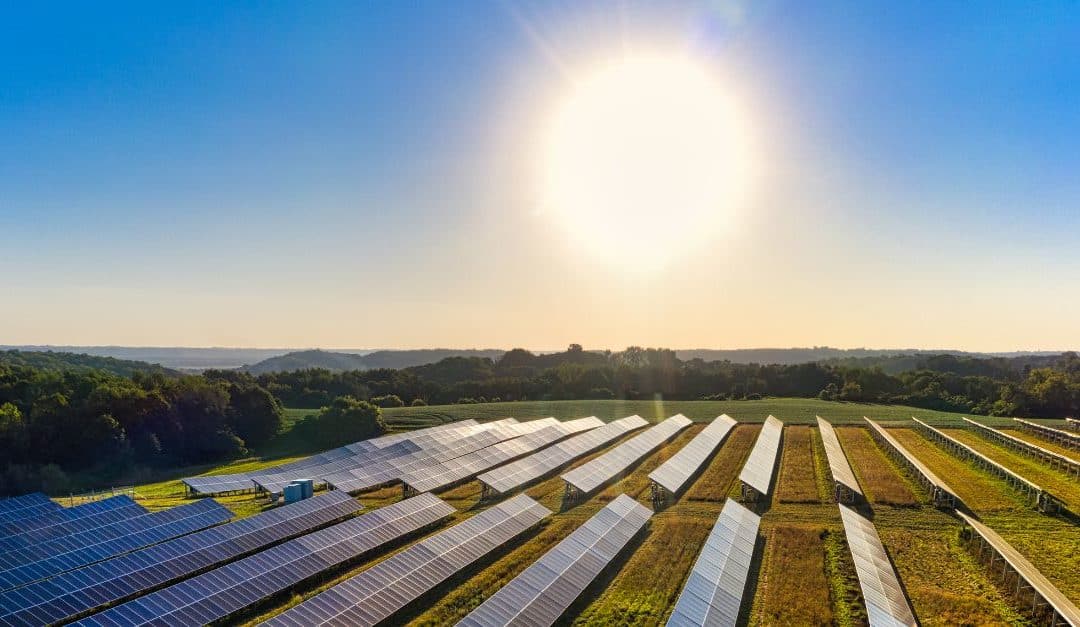
by Chris Hargreaves | Dec 10, 2023 | Energy, New Zealand Energy Certificates, News, Sustainable Business
Contributed by Paul Coster, Founder of EVA Marketplace
Given the need for businesses to slash fossil fuel consumption, part 1 asked the burning question, ‘can backing renewables be both a pragmatic commercial decision and contribute to climate action?’ I then explained that the climate-friendly way for most New Zealand businesses to back renewable energy is through electricity, by both demand response and supporting additional renewable generation.
Here in part 2, I will start by detailing the solutions available to businesses, explain the role played by energy certificates, and then discuss which solutions can have the most impact.
Solutions
Readily available solutions for supporting renewable electricity are shown below. Each of these solutions requires an electricity supply agreement, and some require a power purchase agreement (PPA). See this recent blog post by EVA to learn more about PPAs and how they differ from supply agreements.
Businesses can combine solutions for greater impact, such as having demand response, on-site generation, and a corporate PPA. In all cases, a relationship with an electricity retailer is retained.
1. Demand response
Technology is installed on the business’s site that allows electrical equipment (including battery storage) to respond to changes in the electricity market, such as high prices or plentiful renewable generation.
Use case: industrial facility installing technology to switch between an electric boiler and a thermal (e.g. biomass) boiler to produce steam. The thermal boiler is used during high prices or when the carbon intensity of the grid is high. An example is
Open Country using Simply Energy’s technology.
2. On-site generation
Renewable generation is installed on or near the business’s site. The project is owned by the business, or owned by a developer who agrees to sell the electricity onto the business via an on-site PPA.
3. Corporate PPA
Renewable generation is constructed remotely (‘off-site’). The project is owned by a developer who agrees to sell the electricity to the business via a corporate PPA, helping to financially support their project. The corporate PPA will typically be sleeved (bundled) into the business’s supply agreement.
4. Indirect utility PPA
Renewable generation is constructed off-site. The project is owned by a developer who agrees to sell the electricity onto a retailer via a utility PPA, helping to financially support their project. The retailer on-sells the electricity to the business under similar terms using PPA sleeving (bundling).
5. Project-linked supply
Renewable generation is constructed off-site. The generator agrees to sell the project’s renewable attributes onto a retailer via energy certificates. The retailer passes the certificates onto the business under their electricity supply agreement or another agreement.
Use case: a business that receives energy certificates from a new renewables project under their electricity supply agreement.
Energy certificates
Energy certificates play an essential role for these solutions where renewable electricity is exported into a network. The certificates track renewable attributes for each unit of electricity, avoiding double counting (*1) and reducing the chance of mis-leading claims (*2).
Currently, energy certificates don’t consider the impact of a solution, such as its economic, environmental or social benefits. In New Zealand, issuers of energy certificates are Brave Trace. (NZ-ECs) and Energy Market Services (iRECs). Certified Energy recently announced future plans to add an impact attribute to their certificates.
Impact
In assessing the potential impact of each solution, we’re going to focus on their economic and environmental impact. The social impact of each solution will greatly depend on the approach taken by the project developer (e.g. community involvement and initiatives).
In order to assess potential impact, I considered various factors, including these three key solution characteristics by asking the following questions:
- Additionality: To what extent would the avoided system emissions have occurred in absence of the solution?
- Location: How does the physical location of the solution (on-site or off-site) affect energy cost savings and avoided costs or emissions?
- Timing: How does the timing of the demand response or electricity generation affect energy cost savings and avoided costs or emissions?
A broad brush assessment of each solution’s potential impact, based on NZ’s current market and the evidence I’ve seen, is shown below. In the complex real-world, the impact will vary for each individual solution (or combination of solutions) and, in the case of demand response, how it is operated day-to-day. Discussion of real-world impact is rich and requires its own series of blog posts.
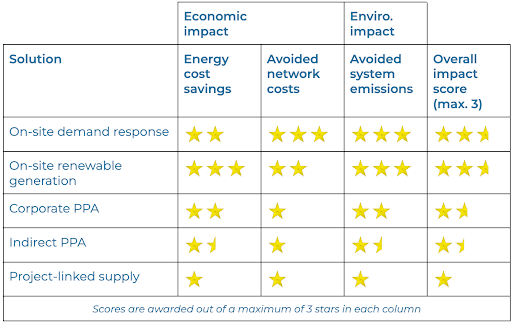
Generally, demand response and on-site generation, particularly when combined, have the highest potential for commercial and climate impact. They’re followed by PPAs, an excellent solution for businesses where on-site solutions aren’t feasible or can’t meet their full electricity needs. Solutions that solely rely on energy certificates, like a project-linked supply, will typically have the lowest impact. Their impact depends on the revenue created by the certificates and how this money is used (businesses should request transparency).
Like part 1, this post is my current thinking, which I hope opens up more discussion about the impact businesses can have on Aotearoa’s clean energy transition.
* References
1. “The GHG emission reductions or removals from the mitigation activity shall not be double counted, i.e., they shall only be counted once towards achieving mitigation targets or goals”, Core Carbon Principles, The Integrity Council
2. Energy certificates can be used to claim lower scope 2 emissions, and are therefore a form of carbon credit or offset. To be high integrity offsets, they should align to The Integrity Council’s Core Carbon Principles.
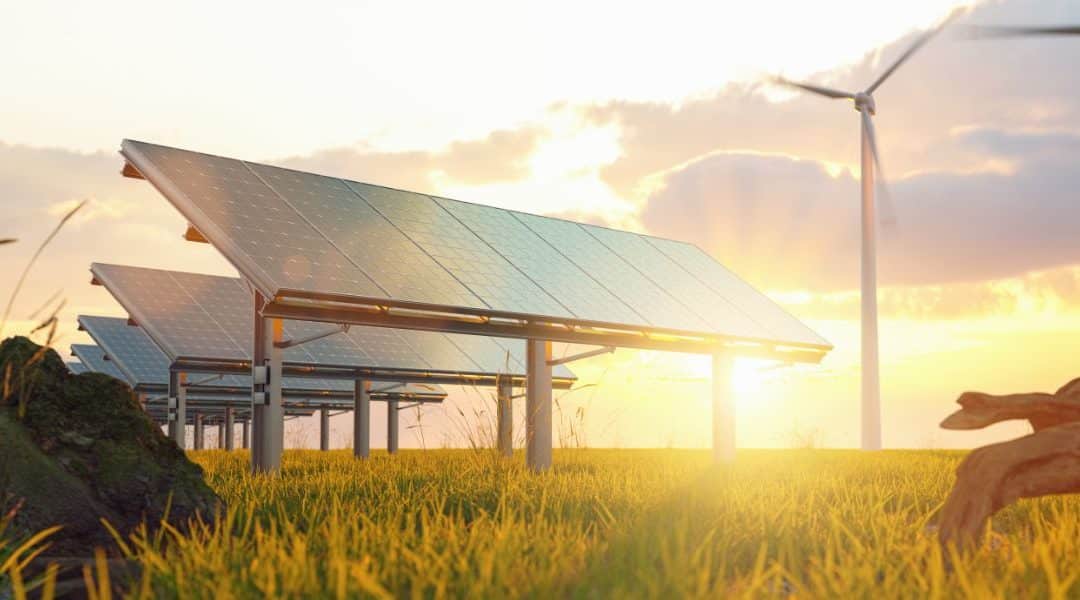
by Chris Hargreaves | Nov 14, 2023 | Energy, New Zealand Energy Certificates, News, Sustainable Business
Contributed by Paul Coster, Founder of EVA Marketplace
As businesses navigate the need to slash fossil fuel usage, the burning question is: can backing renewables be both a pragmatic commercial decision and contribute to climate action?
Some businesses may be surprised that while Aotearoa’s electricity is ~85% renewable, our energy consumption is only ~30% renewable. This means around 70% of New Zealand’s energy consumption is met by burning gas, oil and coal, mainly for transport, heat and electricity production.
So, how do businesses burn less fossil fuel, and therefore meaningfully contribute to climate action? There are three main options:
-
- Eliminating or reducing fossil fuel use (e.g. reduce air travel, encourage active and public transport)
- Increasing energy efficiency (e.g. improve building insulation)
- Supporting renewable energy
In this article, I’m going to focus on ‘supporting renewable energy’, which is a more nuanced topic than you might think. Currently, there are two climate-friendly options for New Zealand businesses to support renewable energy:
- Demand response: consume more electricity when renewables are plentiful, and less when gas and coal-fired generation is running.
- Additional renewables: procure electricity in a way that helps to add more renewables to the electricity system.
At this juncture, I need to briefly discuss three other commonly discussed renewable energy options:
- Green hydrogen (hydrogen made from renewable electricity)
- Biogas and biomethane
- Woody biomass
Globally, green hydrogen is in its early stages and, in New Zealand, biogas and biomethane are in their infancy. Currently, woody biomass is primarily used in the wood, pulp, and paper sectors, where harvest residuals are readily available (*1).
Experts and scientists are cautious about the scope of these fuels in the clean energy transition due to issues such as: green hydrogen’s inefficiency compared to direct electrification of heat and most land transport (*2), the challenging economics of large-scale biogas/biomethane production in New Zealand (*2), and elevated CO2 emissions over decades created by burning woody biomass produced from whole trees (*3 & *4). In my view, woody biomass production should be limited to harvest residuals, and priority given to its use as energy storage to address electricity shortages.
Ok, returning to demand response and additional renewables:
Demand response
Demand response (also called ‘load shifting’) is the shifting of electricity consumption into periods of time when renewables are plentiful (and out of periods of time when it’s scarce), and was discussed last month by Andy Cooper from The Energy Collective.
Andy explained how businesses can use demand response to save money, reduce scope 2 carbon emissions, and help defer costly investment in the electricity network. He also discussed current limitations of Renewable Energy Certificates (RECs), also called Energy Attribute Certificates (EACs).
Additional renewables
It’s necessary to support additional renewables such as wind and solar, otherwise new electricity demand (e.g. EVs, heat pumps) will need to be met by gas or coal-fired generation.
According to the Climate Change Commission, Aotearoa needs approximately an additional 1,000 GWh of renewable electricity every year between now and 2030 to meet our climate targets. That’s around 2.5% of New Zealand’s annual demand (~40,000 GWh), roughly equivalent to 300 MW of wind or 550 MW of solar, every year.
So, how can businesses help add renewables to New Zealand’s energy system? Impactful and readily available solutions for businesses are:
- On-site renewable generation (e.g. rooftop solar)
- Corporate Power Purchase Agreement (PPA) (*5) with a renewable generation project (i.e. a business buys electricity directly from a generation project)
- Indirect PPA with a renewable generation project (i.e. a PPA entered into by an electricity retailer on behalf of a business)
- Electricity supply agreement (*6) linked to a renewable generation project
Businesses can combine these solutions, such as having on-site generation, a corporate PPA and an electricity supply agreement. Combining a PPA with a supply agreement is called PPA ‘sleeving’. For all solutions, businesses retain a relationship with an electricity retailer.
In Part 2, I’ll look at each solution in detail, discuss their pros and cons, and explain why solutions 1 and 2 tend to be the most impactful. I’ll also discuss the important role played by RECs, or EACs, explaining why these certificates should be used in most cases.
These posts are my current thinking, which I hope opens up more discussion about the impact businesses can have on Aotearoa’s clean energy transition.
—
About Paul Coster
Paul is the Founder of EVA Marketplace, Aotearoa’s marketplace for renewable PPAs. EVA assists businesses by matching them to renewables projects, facilitating PPA negotiations, supporting green products (including RECs/EACs) and enabling corporate PPA sleeving. EVA also publishes a quarterly report on the renewables market.
Total Utilities works with EVA to offer customers the option of a corporate PPA sleeved into their electricity supply agreement, helping to control electricity costs and ethically reduce carbon emissions, while retaining the convenience of an FPVV supply arrangement.
* References
- Biomass energy in New Zealand, EECA
- 2023 Draft advice to inform the strategic direction of the Government’s second emissions reduction plan, Climate Change Commission
- Why burning trees for energy harms the climate, World Resources
- 500+ scientists tell EU to end tree burning for energy, WWF
- PPAs tend to be longer term contracts (5 – 15 years) where a buyer commits to buying electricity from a specific project, such as a solar farm, usually at a fixed price.
- Electricity supply agreements tend to be shorter-term contracts (1-5 years) where buyers purchase electricity from a retailer for their sites or buildings, typically at a fixed price.
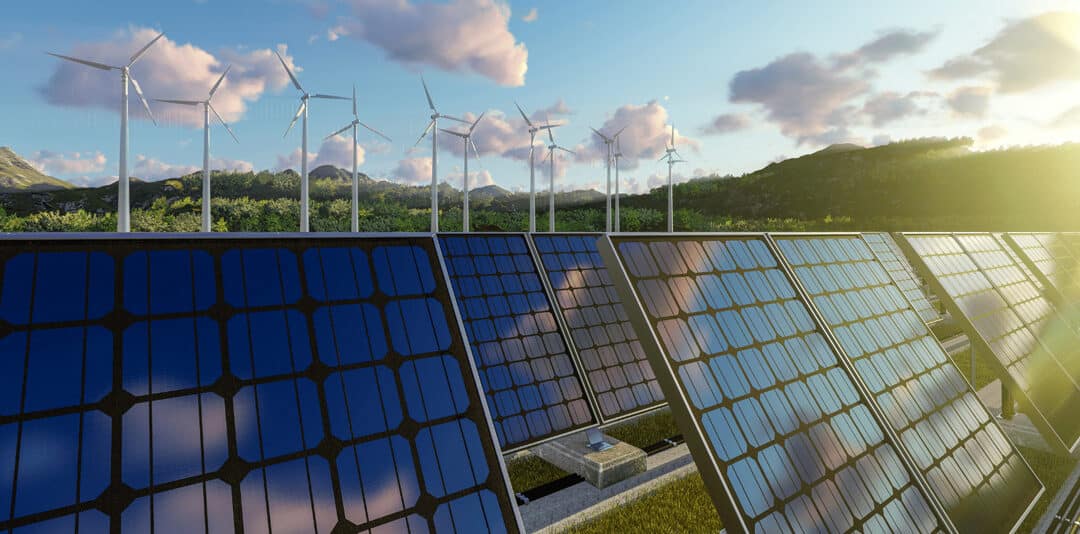
by Jonathan Gardiner | Aug 19, 2022 | New Zealand Energy Certificates, NZ-ECs, Sustainable Business
Total Utilities Management Group is excited to announce our registration on the ‘New Zealand Energy Certificate System (NZECS)’ – enabling our clients to support renewable generation and reduce their reportable emissions.
Administered and developed by BraveTrace, NZECS allows energy consumers to offset their reportable electricity related greenhouse gas emissions and support renewable energy by buying New Zealand Energy Certificates (NZ-ECs) to redeem against their consumption.
What are New Zealand Energy Certificates (NZ-ECs)? NZ-ECs show how and when energy was generated, and from where. This information is referred to as a ‘generation attribute.’ NZ-ECs can be traded and transferred from electricity generators to electricity retailers, who can ultimately sell these certificates to energy consumers. Through the purchase of a certificate, a consumer ‘reserves’ that unit of generation as their own – enabling them to make a clear statement about the type of electricity that they support.
This means that Total Utilities can now act as an independent broker of NZ-ECs and can buy and trade certificates on behalf of our customers to support them to invest in 100% renewable energy.
Certificates can be used to report zero-carbon electricity usage in accredited Greenhouse Gas Reporting Programmes and are a competitively priced alternative to carbon offsets that also offer the potential for greater impact.
By using Total Utilities as your independent broker for NZ-ECs, you can also be assured of straightforward, flexible contract terms – regardless of whether your energy use is big or small.
Fully Transparent Reporting
New Zealand is a relatively late adopter of a system of tradable energy certificates. Certificates create supply chain transparency with the attributes of each certificate outlining energy generation source, age of the generator and whether or not the generator is certified net zero carbon.
Electricity purchased directly from the grid in New Zealand comes from sources which are on average 80% renewable, however, depending on where and when it is purchased, the actual makeup of energy being delivered can vary sharply. This means that up until now, consumers of electricity had no way to link their consumption directly with a renewable generator.
BraveTrace’s NZ Energy Certificate System changes all this…
NZ-ECs prove that purchased energy is directly tied to a 100% renewable energy generator. They also allow energy consumers to report zero related greenhouse gas emissions and thus, to invest in a sustainable future for New Zealand.
NZ-ECs not only provide a fully transparent method of reporting, but also incentivise generators of renewable energy, who can sell their energy certificates on the open market. Total Utilities currently manages around half a billion dollars per year of utility contracts on behalf of our clients and sustainability has become a major strategic objective for many of these businesses.
We are fully committed to assisting our clients move towards 100% renewable energy, helping them in their journey towards net zero emissions.
Total Utilities Managing Director, Jonathan Gardiner, reacts to our registration on NZECS…
“We thrive on energy competition, and our registration as a participant in the New Zealand certificate market allows our customers to get the best of both worlds – full energy market competition, and quick sustainability wins with New Zealand Energy Certificates.
“By choosing to only offer NZ-ECs from suppliers which meet the strict Toitū Envirocare compliance criteria, our clients can report zero-carbon electricity usage in accredited GHG programmes, be part of New Zealand’s renewable energy future and meet carbon reduction targets.
“Electricity is a major cost and driver of emissions for many of our clients, so providing an independent service to negotiate energy supply contracts along with NZ-ECs means our clients can choose to take energy supply from any retailer whilst also meeting their sustainability goals.
“The certificates help create a circular economy as sellers of certificates are required to invest the revenue they earn from certificates in new renewable generation or decarbonisation projects. Purchasers of certificates are investing in a sustainable future for New Zealand.”
“By being amongst the first NZ-based participants to register on Certified Energy’s NZ Energy Certificate System, Total Utilities underlines our commitment to providing customers with the most powerful tools in their journey towards adopting renewable energy sources and moving towards net zero emissions.”
Sign up below for Total Utilities Market Commentary to receive all the latest market news and insights.







